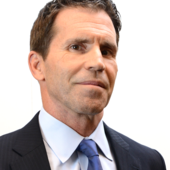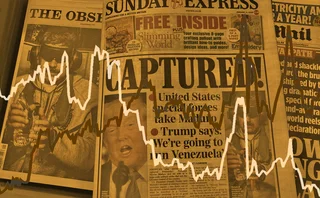
David Rutter: gambling on blockchain and a Treasuries revolution
Former BrokerTec chief says technology can transform financial markets

When David Rutter ran US Treasury trading platform BrokerTec, he had a neat way of telling whether a trader preferred his platform over rival eSpeed. On a sales visit to a bank, he'd throw them a stress ball and see whether they caught it with their left or right hand. Then he'd check which side of the desk their BrokerTec and eSpeed keypads were on. If the BrokerTec keypad was on the wrong side, he'd take his salesmen outside and give them hell.
That zeal helped propel BrokerTec from a 16% share of the Treasuries market when Rutter took over in 2003, to a share of 60% less than two years later – a grip it maintained through to his departure almost a decade later.
Much has changed for both Rutter and the Treasury markets since then. After departing BrokerTec parent Icap in 2012 following a high-profile disagreement with chief executive Michael Spencer – they're good friends again now, he says – Rutter had plenty of time to plot his next move.
He began exploring the potential applications of the fast emerging technology blockchain, which at that time was largely synonymous in the public mind with bitcoin. Assembling a small team of advisers, Rutter set about raising a fund with the aim of investing in the distributed ledger technologies that power cryptographic currency platforms.
"It was a gamble," he says. "When I left Icap, I was 50 years old; if I went to the effort of raising a $100 million fund and spent seven years finding out I wasn't very good at investing it, that would've been a waste."
It turned out not be. Three years later, Rutter is managing partner of R3 CEV, the vast, bank-led consortium he founded to invest in and develop blockchain-inspired technology. He is also founding chief executive of its subsidiary platform, LiquidityEdge, which offers US Treasury trading via a peer-to-peer network – competing with his old shop BrokerTec and Nasdaq's eSpeed. Liquidity providers include the likes of Credit Suisse, as well as a number of non-bank liquidity providers such as Global Trading Systems.
Getting there wasn't a simple process of finding a promising start-up and investing in it, though.
"In 2014, I spent three days in Palo Alto looking at 20 companies, with the purpose of finding one or two to invest in. I was amazed at the number of companies we met who had a 12-page PowerPoint and a decent educational background, but no understanding of how Wall Street works. Yet these guys were looking to raise $10 million at silly valuations, with pitch lines like: ‘We will destroy the Depository Trust & Clearing Corporation in two years'; ‘JP Morgan won't be necessary in five years'; ‘CLS will be gone in three years'. I said, ‘tell me what CLS does'. They were completely unaware of the crucial role these institutions play in global financial markets," he says.
They said, ‘oh, it's bitcoin!' And I said ‘no, it's not bitcoin!' It's an innovation inspired by the use of cryptographic maths, but it's not about trust-less transfer of value
David Rutter, R3
Instead, Rutter and his team set about exploring technologies that could offer practical applications of distributed ledger technology to the financial markets. Distributed ledgers work with so-called smart contracts, converting the terms and obligations of financial agreements into code.
Rutter quickly saw that permissionless blockchains such as bitcoin – in which every node on a network sees and receives all of the data distributed across it – would be inappropriate for the financial markets, from both a processing workload and information security point of view. The consortium instead focused its efforts on developing shared ledger technology, where only the nodes to whom the information pertains – the counterparties to a trade, for example – are sent the data.
The early development phase was tough, Rutter says – but perhaps the harder part was pitching the idea to the banks.
 "They said, ‘oh, it's bitcoin!' And I said ‘no, it's not bitcoin!' It's an innovation inspired by the use of cryptographic maths, but it's not about trust-less transfer of value – because of course guys, we all trust each other; our market has documentation and legal underpinnings, and we transfer billions of dollars to each other all the time."
"They said, ‘oh, it's bitcoin!' And I said ‘no, it's not bitcoin!' It's an innovation inspired by the use of cryptographic maths, but it's not about trust-less transfer of value – because of course guys, we all trust each other; our market has documentation and legal underpinnings, and we transfer billions of dollars to each other all the time."
Perhaps the most exciting fruit of R3's labours is the Corda platform. Formally unveiled last month, the distributed ledger technology can dramatically increase the speed at which standardised financial contracts between banks – International Swaps and Derivatives Association master agreements or credit support annexes, for instance – can be exchanged. It does this by replicating the various elements as bits of code, stored on a shared ledger.
That would open the door for certain trades to be executed with little human involvement. All counterparties to a trade would simply need to amend the relevant terms – a straightforward exercise which at present is often done manually. With the reduced transaction, clearing and settlement times that could result, the potential savings to banks are enormous, says Rutter.
"In addition to the tests our bank partners are running on Corda, we have also been conducting use-cases based on interest rate swaps and commercial paper on various blockchain-inspired technologies, which have given us an in-depth understanding of the requirements for smart contracts to be applied successfully to rates and other financial transactions. The potential cost and efficiency savings are very significant. We have identified a number of areas that require deeper exploration, such as payments, clearing and settlement and static reference data, and they will all require some self-executing or smart contract components," he adds.
Rutter, meanwhile, still enjoys the cut and thrust of running a trading platform in the form of LiquidityEdge. He believes central limit order book (Clob) platforms such as BrokerTec and eSpeed are still highly relevant for the dominant players in the Treasury markets – but not midsize and smaller firms, who are unable to compete with the bigger banks and high-frequency trading firms based on speed alone.
We have identified a number of areas that require deeper exploration, such as payments, clearing and settlement and static reference data, and they will all require some self-executing or smart contract components
David Rutter, R3
"The driver for us is recognising parts of the US Treasury market are grossly underserved by Clobs, and offering something different. If I'm a small dealer and I can't afford colocation services, or to execute in ways that mask what I'm doing, it doesn't mean the Clobs are offering a bad service; it just means it's not the service for me and the way I deal," he says.
LiquidityEdge has designs on moving into the US corporate bond market, Rutter confirms – but says any such move is likely to be two to three years away.
"You feel pain when you try to change too much, too early. We're introducing a minor workflow change to a market that's used to electronic trading. Going in and trying to introduce e-trading in a market that is used to voice is magnitudes harder. Even the smallest of changes take time – not just because of the legacy technological infrastructure that resides within banks and their small tech budgets, but even the habits of traders themselves. We are focusing our efforts on Treasuries to begin with and will then look to extend into other products, but corporate bonds is a market that just isn't ready to change yet," he says.
Only users who have a paid subscription or are part of a corporate subscription are able to print or copy content.
To access these options, along with all other subscription benefits, please contact info@risk.net or view our subscription options here: http://subscriptions.risk.net/subscribe
You are currently unable to print this content. Please contact info@risk.net to find out more.
You are currently unable to copy this content. Please contact info@risk.net to find out more.
Copyright Infopro Digital Limited. All rights reserved.
As outlined in our terms and conditions, https://www.infopro-digital.com/terms-and-conditions/subscriptions/ (point 2.4), printing is limited to a single copy.
If you would like to purchase additional rights please email info@risk.net
Copyright Infopro Digital Limited. All rights reserved.
You may share this content using our article tools. As outlined in our terms and conditions, https://www.infopro-digital.com/terms-and-conditions/subscriptions/ (clause 2.4), an Authorised User may only make one copy of the materials for their own personal use. You must also comply with the restrictions in clause 2.5.
If you would like to purchase additional rights please email info@risk.net
More on Markets
Brokers must shift HFT servers after China colocation ban
New exchange guidance drives rush for “proximity colo” in nearby data centres
LatAm FX carry trade shrugs off geopolitical fears
Clients in regional carry positions remain undeterred by US interventions, say dealers
S&P bull run drives interest in reset and lookback hedges
Variable strike put options proved popular alternative hedging format of 2025
US mutual funds slash short euro positions at record pace
Counterparty Radar: Pimco cut $4.6bn of EUR/USD puts in Q3 amid changing stance on dollar direction
Nomura hires new global eFX head
Mark McMillan to oversee e-trading and sales activities in newly created role
Trump’s LatAm gambit spurs FX hedging rush
Venezuela op boosts risk reversals as investors look to protect carry trades
One Trading brings 24/7 equity trading to Europe
Start-up exchange will launch perpetual futures Clob in Q1 after AFM nod
FXGO volumes surge despite fee switch-on
Dealers split on whether levy is behind volume increases across SDPs








